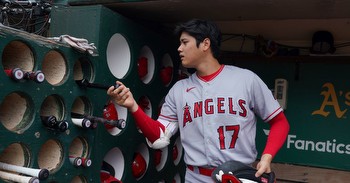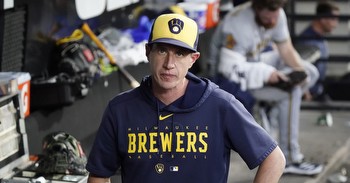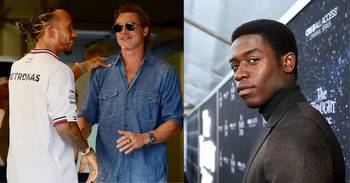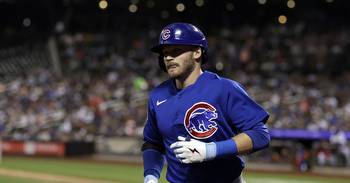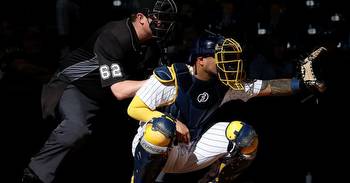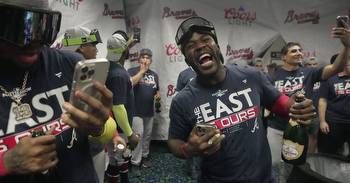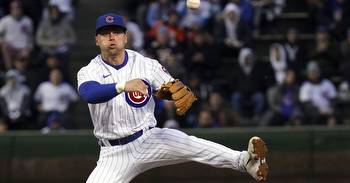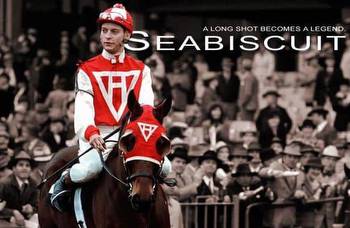Cubs BCB After Dark: The wisdom of Wisdom
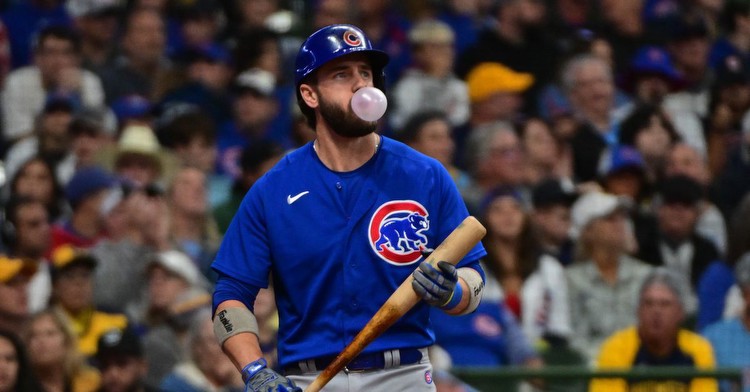
It’s another week here at BCB After Dark: the swingingest set for night owls, early risers, new parents and Cubs fans abroad. We hope you’ve had a great last weekend as we head into the upcoming holiday weekend. As our present to you, there’s no cover charge this evening. There are still a few tables available. Bring your own beverage.
BCB After Dark is the place for you to talk baseball, music, movies, or anything else you need to get off your chest, as long as it is within the rules of the site. The late-nighters are encouraged to get the party started, but everyone else is invited to join in as you wake up the next morning and into the afternoon.
Last week, I asked you about your thoughts about the Cubs signing free agent third baseman Matt Chapman. You were pretty much against the idea, as 54 percent of you put in a “Nay!” vote. Only 24 percent gave it a “Yay!” and the rest were firmly in the “meh” category.
The Cubs also made a minor move tonight.
Escobar, a 31-year-old lefthander, was a top 100 prospect in 2014 and was half of a deal that sent Jake Peavy from Boston to San Francisco. He eventually ended up in Arizona, where he struggled in the majors in 2016. Escobar then signed with the Nippon Ham Fighters in 2017, who traded him later that year to the Yokohama BayStars. He’s pitched for the BayStars since then and has been an effective reliever in NPB, posting a 3.17 ERA over 395 games. We don’t have terms of this deal yet, but it’s likely a minor league deal with a non-roster invitation to Spring Training.
Edwin Escobar is also not only the cousin of retired pitcher Kelvim Escobar, but he’s also a cousin to Nationals shortstop Alcides Escobar and, saving the best for last, a cousin of reigning NL MVP Ronald Acuña Jr.
Tonight’s a special night here at AD as we begin our BCB Winter Western Classic. Last winter, we did a movie tournament for film noir and it went really well—much better than I expected. So we’re going to do it again this offseason with Westerns. I’m not as well-versed in Westerns as I am in noir, but hopefully I’m going to learn along with you. And I have seen every film in the tournament at least once.
I want to keep my write-ups of the films in the tournament reasonably short. Unfortunately, I think failed at that task tonight. But I appreciate everyone who reads it. I also think we have the potential for an early upset here in our first vote.
So here’s the part where I put the music and the movies. Those of you who skip that can do so now.
Pianist Isaiah J. Thompson has a new album out featuring the music of pianist Vince Guaraldi. In particular, it’s on the “holiday” music of Guaraldi and that means the stuff you grew up loving on the Peanuts holiday specials.
So in honor of Thanksgiving this week, here’s Thompson playing the Thanksgiving Theme from “A Charlie Brown Thanksgiving.”
Welcome to the Opening matchup of the BCB Winter Western Classic! We have a list of 28 really classic movies about the American West and we’re going to put them up against each other in a NCAA basketball-style tournament. Every Monday and Wednesday night, you are going to get to vote between two films from the years 1939 to 1972. How this works is that you vote for one of the two films each night to advance. You don’t have to have seen the film to vote—I have no way of checking whether you have or haven’t. But the purpose of this tournament is to have some fun and talk about old movies. And maybe learn about a few films that you might be interested in checking out in the future—either for the first time or for a re-watch.
I picked films between 1939 and 1972 because that is the period that I consider to be the heyday of the Western. Most oaters before 1939 were designed as light entertainment for children. After Stagecoach released that year, Hollywood—and later radio and television—went nuts churning out tales of the old frontier. But while there continued to be Westerns made after 1972, the genre fell out of favor with the American public in the early 1970s. During the 1959-60 American television season, there were 35 Westerns that aired in primetime on the three networks. That doesn’t even count several syndicated Westerns. By the 1973-74 season, only three remained in primetime.
There are a lot of possible explanations for why the Western was so popular in America (and throughout the world, really) in the middle of the 20th Century. I’ll try to get into that over the course of this tournament. But I don’t want to overwhelm you with a dissertation on our first day, so we’ll just talk about it bit-by-bit as the tournament progresses, as well as other thoughts about the genre.
We’ve got two films dueling tonight and both finish up with a classic Western duel. You know, the kind with two gunfighters try to outdraw each other? The kind that almost never happened in real life but happened in the movies all the time? It’s 1953’s Shane, directed by George Stevens and starring Alan Ladd, Jean Arthur and Van Heflin, facing off against 1954’s Vera Cruz, which was directed by Robert Aldrich and starred Gary Cooper, Burt Lancaster and Denise Darcel.
Shane(#5 seed)
“Come back, Shane!” That’s one of the most famous endings to a movie ever. It’s been endlessly copied and endlessly parodied. Even if you haven’t seen the movie, you’re probably familiar with that ending.
But Shane is a lot more than just its ending. While some of the plot elements seem cliché today, you’ve got to remember that’s just because so many lesser storytellers copied it. A stranger with a mysterious past rides onto a Wyoming farm and sticks around because of a brewing war between the ranchers and the farmers. (This is the basic outline of the Johnson County War, which was also the backdrop of the The Virginian. That’s the 1902 novel by Owen Wister, which is usually considered the first serious Western novel.) The farmers in Shane are generally no match for the ranchers, but Shane’s dark past is clearly full of violence that he’s trying to leave behind. After Shane makes a fool out of the ranchers in a barroom brawl, they call for a mysterious gunfighter (Jack Palance) to try to even out the odds.
In the hands of a lesser filmmaker, this would be routine stuff. But Stevens elevates this into a classic. First of all, the film is gorgeous, shot in color on location in Wyoming. This one one of the biggest budget Westerns ever made. And Stevens is able to effectively contrast the beauty of the Wyoming landscape with the muddy, wooden cabins where the farms try to eke out a meager living. Cinematographer Loyal Griggs won an Oscar for his work on Shane and deservedly so.
In his review of the film as part of his “Great movies” series, critic Roger Ebert emphasized the psychological aspect of Shane. The short, pretty-boy Ladd plays Shane as a tormented soul. This is a man who has seen death and is haunted by it. When confronted by the ranchers, he has this pained look that yet another man has made the fatal mistake of underestimating him.
But Ebert stresses the psychodrama of Shane’s relationship with the Starrett family: Joe (Van Heflin), Marian (Jean Arthur) and little Joey (Brandon deWilde). This is the kind of domesticity that Shane longs for. And while Joe is a honest, hardworking farmer, both Marian and Joey are immediately attracted to this mysterious stranger. Marian is drawn to his good looks and the promise of a life away from a struggling farm. Joey immediately falls into hero worship, seeing Shane as the exciting gunfighter that his boring father isn’t. Shane could easily maneuver Joe into getting killed in this war and then Shane could replace Joe in the Starrett family. Shane is far too honorable and he likes Joe too much to do that. But you can see in Ladd’s face that Shane wishes it were otherwise. And maybe Marian and Joey wish it were otherwise as well. That give Shane a much different dimension than most of these “stranger rides into town” films.
It should also be noted that Shane was the great Jean Arthur’s final movie and the only one she ever made in color. It seems ironic that someone who became famous playing smart-talking city working girls would finish playing a wife on the frontier, but she did have experience playing in oaters, especially in the silent era. Arthur had retired years before Shane was made and she agreed to do the film as a favor to Stevens. (She would later return to the stage and did a little television, but she never did act in a movie again.)
Shane also has Elisha Cook Jr. in a smaller supporting role as one of the farmers who stands up to the ranchers with poor results. Any film with Cook in it gets extra credit in my book.
Besides winning for Color Cinematography, Shane was nominated for an Oscar for Best Picture, Best Director, Best Screenplay and Best Supporting Actor for both Jack Palance and Brandon deWilde.
Here’s the trailer for the re-release of Shane.
Vera Cruz (#28 seed)
Vera Cruz was the first American shot completely in Mexico, although they didn’t actually shoot in Veracruz. Vera Cruz is about Ben Crane (Gary Cooper) a former Confederate officer who lost his plantation in the Civil War and is headed down to Mexico to regain his fortune. When his horse is on his last legs (literally, Ben shoots the horse), he buys a new horse from Joe Erin (Burt Lancaster), a fellow American who is the head of an outlaw gang down in Mexico. They’re forced to work together when government forces try to kill them. As it turns out, the horse Joe sold Ben was stolen from the officer.
Ben and Joe get caught between two sides in the Mexican rebellion against the Emperor Maximilian (George Macready). Eventually, they talk their way into the good graces of the Emperor (their shooting skills play a big part in that) and Ben, Joe and Joe’s gang agree to take a job escorting the countess Marie (Denise Darcel) and the Marquis Henri (Cesar Romero) to Veracruz where the Countess is supposed to get on a ship to Paris to escape the war.
Except that’s not exactly why she’s going to Paris. Ben and Joe discover that the countess is actually carrying $3 million in gold to buy mercenaries in Europe to fight the revolutionary Juaristas. Also, Mexican girl Nina (Sara Montiel) had stowed away on the carriage train to Veracruz—supposedly because she’s attracted to Ben. But she has a ulterior motive. In fact, almost everyone in this film has a hidden motivation.
In many ways, Vera Cruz is a con man movie. Everyone in this picture has a secret agenda and is planning to betray the everyone else at some point for the gold. Cooper’s Ben becomes the good guy in this film basically by being less rotten than everyone else. He decides to do the right thing in the end, although he does expect to be handsomely rewarded for it.
Vera Cruz is also an exceptionally violent film for 1954 and paved the way for the more violent takes on the Old West that would come later in the 1960s. In fact, many directors of the sixties cited Vera Cruz as an influence. It should come as no surprise to those of you who followed last year’s Noir Classic. Aldrich next directed Kiss Me Deadly in 1955, which again, was a much more violent take on the noir genre.
Beyond Cooper and Lancaster turning in great performances, Joe’s gang of outlaws features some actors who would become very big names in the near future. Ernest Borgnine is one and Charles Bronson—-credited under his real name of Charles Buchinsky—is another. But I also want to mention the scene-stealing performance of dancer/choreographer Archie Savage, playing another one of Lancaster’s outlaws. First, I give credit to Aldrich for casting a Black man in a Western—way too many films of this time ignored the presence of African-Americans on the frontier or just cast them as servants—basically just surrogate slaves. But while Savage’s character of Ballard only has one or two lines, whenever the gang stopped for a party, Ballard does some amazing dance routines. A lot of Westerns take a break in the plot for a song, but Vera Cruz take a pause to highlight some modern dance. My only complaint is that the dances are too short.
I know a lot of you loved the trailer for Aldrich’s Kiss Me Deadly last year. The trailer for Vera Cruz isn’t quite as good, but it’s still pretty good.
So now it’s time to vote. As I’ve said before, you don’t have to have seen the films to vote. I wouldn’t know if you had or not.
You have until Wednesday evening to vote.
Next up is the #6 seed, Butch Cassidy and the Sundance Kid (1969) going up against our #27 seed, Forty Guns. Butch Cassidy can be seen on Max and Forty Guns is on the Criterion Channel and on Tubi, free with ads.
Welcome back to everyone who skips the music and movies.
This past Friday was the MLB non-tender deadline and the Cubs non-tendered three players, all pitchers: right-hander Codi Heuer, right-hander Ethan Roberts and left-hander Brandon Hughes.
But while those moves seemed uncontroversial enough. it was the player that the Cubs didn’t non-tender that seemed to strike some Cubs fans wrong. That was third baseman Patrick Wisdom, whom at the same time as the non-tenders, the Cubs announced that they had signed Wisdom to a new one-year deal, avoiding arbitration. We don’t know the exact amount of the deal, but it’s generally been reported as around $2.7 million.
I was surprised at home many Cubs fans seemed upset by the deal with Wisdom. No, he’s not a star and he has a lot of flaws. But he hits left-handers pretty well and he’s got plus power versus everyone. It’s not like $2.7 million is a lot of money in MLB these days, and although he does occupy a valuable roster spot, Wisdom seems like a solid bat off the bench and occasional starter at the two corner infield positions.
But what do you think of the decision to bring back Wisdom for another season? Do you think that he is a good value at that price, or do you think the Cubs would be wise to move on from Wisdom?
Poll
Bringing back Patrick Wisdom for 2024?
Thanks to everyone who stopped by this evening. We hope we got your holiday week off to a good start. Don’t forget to vote by Wednesday. Stay warm. Please get home safely. Tip your waitstaff. And join us again tomorrow evening for more BCB After Dark.

